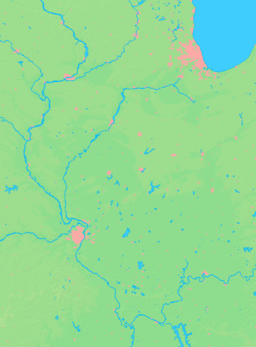Wauconda, Illinois
| Wauconda, Illinois | |
| Village | |
| Motto: "The Village with a View" | |
| Country | United States |
|---|---|
| State | Illinois |
| County | Lake |
| Coordinates | 42°16′1″N 88°8′34″W / 42.26694°N 88.14278°WCoordinates: 42°16′1″N 88°8′34″W / 42.26694°N 88.14278°W |
| Area | 5.73 sq mi (15 km2) |
| - land | 5.05 sq mi (13 km2) |
| - water | 0.68 sq mi (2 km2) |
| Population | 13,603 (2010) |
| Density | 2,374/sq mi (917/km2) |
| Timezone | CST (UTC-6) |
| - summer (DST) | CDT (UTC-5) |
| Postal code | 60084 |
| Area code | 847 and 224 |
  Location of Wauconda within Illinois | |
| Wikimedia Commons: Wauconda, Illinois | |
| Website: wauconda-il | |
Wauconda (/ˌwɔːˈkɒndə/ or /wəˈkɒndə/) is a village in Lake County, Illinois, United States. The population was 13,603 at the 2010 census.[1] It is the site of the Wauconda Bog Nature Preserve, a National Natural Landmark. Wauconda Community Unit School District 118 serves students from kindergarten through 12th grade who live in Wauconda and surrounding communities (Island Lake, Lakemoor, Volo, and unincorporated sections of McHenry County). Fremont School District 79 also serves students from communities from northern part of Wauconda.
Government
Wauconda's local government consists of a Mayor, Clerk, and six-member Board of Trustees who are elected to four-year overlapping terms of office. Village Board meetings are held on the first and third Tuesday of the month. Committee of the Whole meetings are held the second, fourth and sometimes fifth Tuesday of the month.
The Village Administrator oversees all village departments and serves as a liaison between the village residents and the Board. The Administrator supervises the daily operations of the village with the assistance of staff, including the Chief of Police and the directors of Public Works, Finance, Human Resources/Risk Management, Information Technology, Environmental Quality, Building and Zoning, and Economic Development.
There is a library on Main Street, called Wauconda Area Library, which serves the village.
History
Traditions say that Wauconda was named for an Indian chief by that name (originally spelled "Wakanda"), who is buried somewhere on the southern bank of Bangs Lake, where the town hall was later built. The word translated from its Indian language means "Spirit Water".
By the time the earliest permanent settlers of European descent arrived, most Natives had migrated westward. In 1840, a remnant of the Winnebago tribe lived on the shores of the Fox River and came to Wauconda to trade. Several tribal mounds were found near here, and it is probable that there was a native encampment at Slocum Lake.
In 1836, Elihu Hubbard built a log cabin on the bank of the lake. In 1848, Justus Bangs, the first settler, built a home where the town hall now stands, and it was for him the lake was named. Wauconda was organized in 1849, and the first town meeting was held the first Tuesday in April, 1850.
Most of the early settlers came from New England and New York. They came by covered wagon, and some came through the Erie Canal and the Great Lakes.
The first main street ran along the bank of the lake, and the streets leading into it were lanes. The area's primary thoroughfares served as fords to both the inlet and outlet of the lake.
The stage route from Chicago to Janesville, Wisconsin, went through Wauconda. Ambrose Bangs drove the stage from Chicago to Janesville for eight years. It took him one week to make the round trip.
The first post office was at Slocum Lake, but the settlement did not prosper, so on June 27, 1849, it was moved to Wauconda. The first postmaster at Wauconda was Hazard Green.
The first Baptist church was organized in the fall of 1838 by Elder Joel Wheeler of McHenry. A church was built by the Methodists in 1856 on the Common and was occupied by both Methodists and Baptists on alternate Sundays until February 1870, when the Baptists organized and in the summer of 1870 built a church at the cost of $5,500.00, dedicated October 30, 1870, free of debt. The Methodist church was organized Sept. 3, 1852, under the direction of Rev. C. French.
A Roman Catholic church was built in 1877, and the first trustees were James Murray, Charles Davlin, Felix Givens, Hugh Davlin, and Owen McMahon. The first priest was Father O'Neil.
There was a saw and grist mill at the foot of Mill Street near the lake. It burned in 1906. There was a brickyard on the Cook farm and another one on the Kent property on Maple Avenue. A limestone kiln was located on the bank of the lake on Kimball's property. At one time limestone was a very profitable business, and there was an abundance around Wauconda. There was a foundry and blacksmith shop where Farman's house now stands.
In 1839, the school district was organized and a schoolhouse built. It stood where the Clark Hotel later stood. It was log, 20 feet (6.1 m) long, and was heated by a fireplace in one end. Books used were Cobb's speller, the Bible, second and third readers and a book on arithmetic.
The population of Wauconda in 1850 was 200, and the town had three goods stores, two public houses and various mechanics.
The amount of the school fund of this township was $3,224.10. The assessed value of property for the year 1850, including both real and personal, was $61,907.00. The amount of tax computed on the same was $827.18.
Geography
Wauconda is located at 42°16′1″N 88°8′34″W / 42.26694°N 88.14278°W (42.266910, -88.142657).[2]
According to the 2010 census, Wauconda has a total area of 5.732 square miles (14.85 km2), of which 5.05 square miles (13.08 km2) (or 88.1%) is land and 0.682 square miles (1.77 km2) (or 11.9%) is water.[3]
Transportation
A small private airport, Air Estates Airport, is located northeast of Mundelein.
Demographics
| Historical population | |||
|---|---|---|---|
| Census | Pop. | %± | |
| 1880 | 298 | — | |
| 1890 | 368 | 23.5% | |
| 1900 | 397 | 7.9% | |
| 1910 | 368 | −7.3% | |
| 1920 | 399 | 8.4% | |
| 1930 | 554 | 38.8% | |
| 1940 | 639 | 15.3% | |
| 1950 | 1,173 | 83.6% | |
| 1960 | 3,227 | 175.1% | |
| 1970 | 5,460 | 69.2% | |
| 1980 | 5,688 | 4.2% | |
| 1990 | 6,294 | 10.7% | |
| 2000 | 9,448 | 50.1% | |
| 2010 | 13,603 | 44.0% | |
| Est. 2015 | 13,814 | [4] | 1.6% |
As of the census[6] of 2000, there were 9,448 people, 3,611 households, and 2,404 families residing in the village. The population density was 2,445.0 people per square mile (945.1/km²). There were 3,822 housing units at an average density of 989.1 per square mile (382.3/km²). The racial makeup of the village was 90.2% White, 0.4% African American, 0.3% Native American, 1.8% Asian, 0.0% Pacific Islander, 6.4% from other races, and 0.9% from two or more races. 11.9% of the population reported being Latino of any race.
There were 3,611 households out of which 100% had children under the age of 18 living with them, 54.2% were married couples living together, 8.3% had a female householder with no husband present, and 33.4% were non-families. 27.4% of all households were made up of individuals and 9.4% had someone living alone who was 65 years of age or older. The average household size was 2.58 and the average family size was 3.16.
In the village the population was spread out with 25.1% under the age of 18, 7.2% from 18 to 24, 35.8% from 25 to 44, 20.5% from 45 to 64, and 11.4% who were 65 years of age or older. The median age was 36 years. For every 100 females there were 101.9 males. For every 100 females age 18 and over, there were 98.1 males.
The median income for a household in the village was $65,805, and the median income for a family was $56,576. Males had a median income of $64,027 versus $43,125 for females. The per capita income for the village was $40,355. About 2.1% of families and 4.0% of the population were below the poverty line, including 2.1% of those under age 18 and 4.0% of those age 65 or over.
Notable people
- Dr Manhattan, a punk rock quartet
- Brent Sherman, driver with NASCAR
Events
Every summer, the Wauconda Chamber of Commerce holds a two-day rodeo to raise funds for their other works. It is the only IPRA-sanctioned rodeo in Lake County.
On January 28, 2005, over 3,000 people participated in a snowball fight for ten minutes, setting a new world record for most participants in such an event.[7]
In popular culture
- The Blues Brothers was partially filmed in the village. A segment of the chase scene during the final third of the film featured the US-12 highway overpass over IL-176 (Liberty St.),[8] as was a scene with the Blues Brothers driving onto Phil's Beach on North Main Street.[9]
- Camp Wauconda is mentioned in the movie Ghostbusters by Dan Aykroyd's character, before the appearance of the Stay Puft Marshmallow Man.
References
- ↑ "Geographic Identifiers: 2010 Demographic Profile Data (G001): Wauconda village, Illinois". U.S. Census Bureau, American Factfinder. Retrieved December 18, 2012.
- ↑ "US Gazetteer files: 2010, 2000, and 1990". United States Census Bureau. 2011-02-12. Retrieved 2011-04-23.
- ↑ "G001 - Geographic Identifiers - 2010 Census Summary File 1". United States Census Bureau. Retrieved 2015-12-25.
- ↑ "Annual Estimates of the Resident Population for Incorporated Places: April 1, 2010 to July 1, 2015". Retrieved July 2, 2016.
- ↑ "Census of Population and Housing". Census.gov. Retrieved June 4, 2015.
- ↑ "American FactFinder". United States Census Bureau. Retrieved 2008-01-31.
- ↑ Record Snow Ball Fight
- ↑ Police Crash Site :: Blues Brothers Central
- ↑ Crowded Beach :: Blues Brothers Central